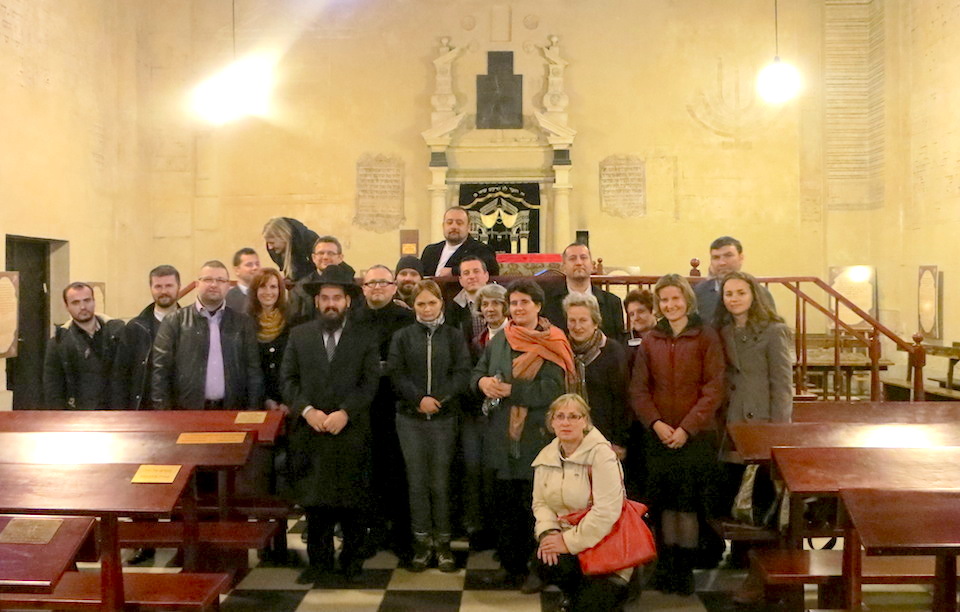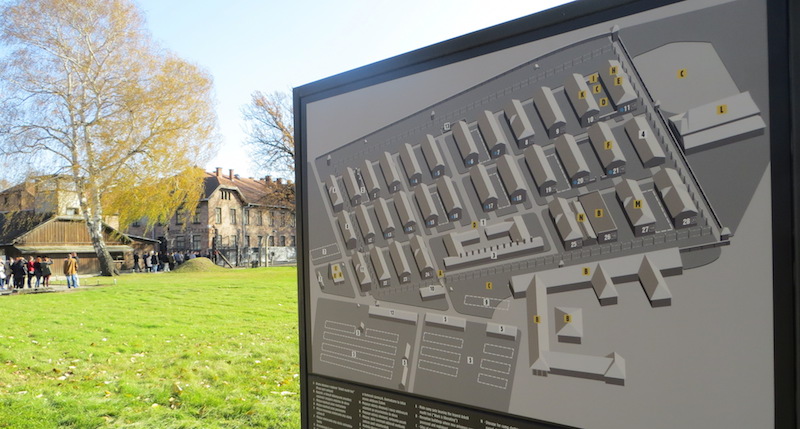Oswiecim / Auschwitz Today
Two things really spoke to us during our visit to Auschwitz: The only reconstructed synagogue in town and an exhibition of modern photos of city life in the present. The photos were displayed in a local coffee shop and were of everyday, simple life events, but closer observation left the viewer with a deep chill: One photo showed a young girl roller-skating under a beautiful, romantic sunset. A closer look shows that the girl is skating on the road right next to the blocks themselves, where thousands of prisoners were held and killed during the war. Another photo looks like a nice Sunday afternoon, with a father and son fishing at a local lake. This would normally be nothing out-of-the ordinary, except for the horrifying realization that this was one of the lakes where tons and tons of human ashes had been dumped…. The sense we were left with after viewing the exhibition is that “life goes on.” And truly, the people of Oswiecim live on (as we all do). But, as we know, this doesn’t mean that we have forgotten….
The stories continue only if we do not forget…
It wasn’t just the places, but the people with whom I had the opportunity to speak that taught me so much. The rabbi of the synagogue in Krakow introduced us to the concept of mourning within Judaism, as well as the boundless joy people experience in the Lord during Sabbath. Our guide through the concentration camp in Auschwitz drew our attention to so many important facts, and at the very beginning of his presentation reminded us that we had not just stepped into a museum, but onto the scene–the place of death for millions of human beings. And lastly, the other participants in the conference touched my heart with their stories. Their life experiences brought so many valuable thoughts and ideas to the conversation. The fact that the participants came from so many different countries and cultures, and spoke different languages (Romanian, German, English, Polish, and Slovak) and hold to several different religions (Protestant, Orthodox, Greek Catholic, Roman Catholic, and Judaism) highlighted the impact of the conference.

The reflection at the end
I perceive each person as a separate universe–gorgeous, expansive, created by God, and full of surprises☺. The participants in this conference were new “universes” for me: They became friends. This meeting added the gift of friendship to my life!
The last section on the conference schedule was a time of reflection, presented in the form of two questions:
- What kind of questions did I have when I came here?
- What kind of questions am I taking home with me?
Thanks to this activity, I began to ask myself what has happened in our recent history that caused people to lose their humanity? What has happened that they no longer see God’s creation (man) as an amazing thing? That they have forgotten that life is a gift – and that the gift is every life! And I began to ask myself also how to tell others about my experience in the concentration camp in Auschwitz – one of the world’s great examples of the horrors of man’s inhumanity to man.

Oswiecim and Auschwitz – let us remember the difference!
However, even today, I remember that one of the most illogical things I was exposed to at that conference was the use of two different terms to talk about the same thing. Those terms are Oswiecim and Auschwitz—two established names for the same death camp. Maybe that’s why I’ll always remember the words of the Orthodox priest from Romania in the final part of our international meeting. He said: “For us, it was a trip to city called Oswiecim to get to know the culture of mourning. But for them (prisoners in the camps), it was their last trip to Auschwitz…”
Hedwi Tkáčová
::: Read also PART 1 :::



